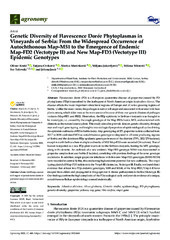Приказ основних података о документу
Genetic Diversity of Flavescence Dorée Phytoplasmas in Vineyards of Serbia: From the Widespread Occurrence of Autochthonous Map-M51 to the Emergence of Endemic Map-FD2 (Vectotype II) and New Map-FD3 (Vectotype III) Epidemic Genotypes
| dc.creator | Krstić, Oliver | |
| dc.creator | Cvrković, Tatjana | |
| dc.creator | Marinković, Slavica | |
| dc.creator | Jakovljević, Miljana | |
| dc.creator | Mitrović, Milana | |
| dc.creator | Tosevski, Ivo | |
| dc.creator | Jovic, Jelena | |
| dc.date.accessioned | 2023-07-14T10:26:15Z | |
| dc.date.available | 2023-07-14T10:26:15Z | |
| dc.date.issued | 2022 | |
| dc.identifier.issn | 2073-4395 | |
| dc.identifier.uri | https://plantarum.izbis.bg.ac.rs/handle/123456789/719 | |
| dc.description.abstract | Flavescence dorée (FD) is a European quarantine disease of grapevine caused by FD phytoplasma (FDp) transmitted by the leafhopper of North American origin Scaphoideus titanus. The disease affects the most important viticultural regions of Europe and all wine-growing regions of Serbia. Unlike the insect vector, the pathogen is native to Europe and associated with several wild host plants among which alder trees as the main source of two out of three map genetic clusters of pathogen variants (Map-FD1 and FD2). Heretofore, the FDp epidemic in Serbian vineyards was thought to be monotypic, i.e., caused by the single genotype of the Map-FD3 cluster, M51, and correlated with clematis as the natural source plant. This study aimed to provide data on genetic diversity, through map and vmpA gene typing, and insights into ecological properties of epidemiological cycles driving the epidemic outbreaks of FD in Serbia today. Map genotyping of 270 grapevine isolates collected from 2017 to 2019 confirmed M51 as autochthonous genotype widespread in all wine producing regions of Serbia and the dominant FDp epidemic genotype in most of the districts (75%, 202/270 isolates), except in north Serbia where multiple outbreaks of M12 Map-FD3 were recorded (54 isolates). Tree of heaven is reported as a new FDp plant reservoir for the Serbian vineyards, hosting the M51 genotype, along with clematis. An outbreak of a new endemic Map-FD3 genotype M144 was documented in grapevine samples from east Serbia (5 isolates), correlating with previous findings of the same genotype in clematis. In addition, single grapevine infections with five new Map-FD3 genotypes (M150-M154) were recorded in central Serbia, thus indicating high endemic potential for new outbreaks. The vmpA typing placed all Map-FD3 isolates into the VmpA-III cluster, i.e., Vectotype III. Finally, we found direct evidence that at least two FDp endemic genotypes, M89 and M148, of the Map-FD2/VmpA-II have escaped from alders and propagated in the grapevine-S. titanus pathosystem in Serbia (Vectotype II). Our findings confirm the high complexity of the FDp ecological cycle and provide evidence of a unique, autochthonous Balkan epidemiology sourced endemically. | sr |
| dc.language.iso | en | sr |
| dc.publisher | MDPI Basel | sr |
| dc.relation | info:eu-repo/grantAgreement/MESTD/inst-2020/200010/RS// | sr |
| dc.rights | openAccess | sr |
| dc.rights.uri | https://creativecommons.org/licenses/by/4.0/ | |
| dc.source | Agronomy | sr |
| dc.subject | Ailanthus altissima | sr |
| dc.subject | Alnus glutinosa | sr |
| dc.subject | Clematis vitalba | sr |
| dc.subject | epidemiology | sr |
| dc.subject | FD phytoplasma | sr |
| dc.subject | genetic diversity | sr |
| dc.subject | grapevine yellows | sr |
| dc.subject | map gene | sr |
| dc.subject | Vitis vinifera | sr |
| dc.subject | vmpA gene | sr |
| dc.title | Genetic Diversity of Flavescence Dorée Phytoplasmas in Vineyards of Serbia: From the Widespread Occurrence of Autochthonous Map-M51 to the Emergence of Endemic Map-FD2 (Vectotype II) and New Map-FD3 (Vectotype III) Epidemic Genotypes | sr |
| dc.type | article | sr |
| dc.rights.license | BY | sr |
| dc.citation.issue | 2 | |
| dc.citation.rank | M21 | |
| dc.citation.volume | 12 | |
| dc.type.version | publishedVersion | sr |
| dc.identifier.doi | 10.3390/agronomy12020448 | |
| dc.identifier.fulltext | http://plantarum.izbis.bg.ac.rs/bitstream/id/2898/bitstream_2898.pdf | |
| dc.identifier.scopus | 2-s2.0-85124622750 | |
| dc.identifier.wos | 000763231000001 |


